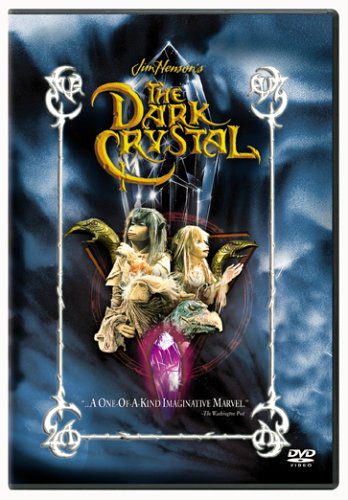What can the science of fractals – and the 80’s movie The Dark Crystal – teach us about the divine drama of Good Friday and the Saturday Easter Vigil? Only the shadow knows . . .
The competing themes of light and darkness during the Good Friday and Saturday Easter Vigil liturgies remind me of Mary Midgley’s essay on “Selves and Shadows” where she delves into the topic of evil, Carl Jung’s concept of the shadow, the story Jekyll and Hyde, and the need to not destroy the shadow-self/enemy, but to embrace it. When I taught about evil in my course on ethics as an adjunct instructor, students really got into this because there are so many cultural references to the shadow:
Frodo and Gollum in Lord of the Rings;
Spider Man and Venom;
Harry Potter and Voldemort;
Glinda and the Wicked Witch in the Wizard of Oz;
Noah and Tubal-Cain in the movie Noah;
Kahn and Starfleet in Star Trek (especially Into Darkness).
Not to mention the great biblical stories of the shadow: Cain and Abel; Jacob and Esau; Jacob and the mysterious figure wrestling by the river Jabbok.
“Love your enemy,” Jesus shrewdly advised. In other words, do not make the “shadow” into the unholy “other,” but embrace it in order to become whole. When we fail to recognize our own capacity for evil, when we try to ignore it or cover it up or hide it away, it splits us and we become dis-integrated. It happens with race, with sexuality, with tribes, and in politics.
This split creates what we might call a fractal – a pattern of competing light and darkness.
The paschal mystery is a fractal mystery
A pastor friend of mine, The Rev. Mike Scholtes, reminded me about the concept of fractals – patterns that repeat themselves in nature. He shared with me an article called “The Fractal Mystery,” by an ELCA pastor named Michael Coffey in Texas. Coffey writes:

As we plunge ourselves into the story of Jesus’ life, suffering, death, and resurrection again, it occurs to me that the paschal mystery of Christ is also the fractal mystery. Fractals, you may know, are the repeating of patterns into a larger whole. A small pattern or shape gets repeated and the sum total is a larger picture that has the same shape and characteristics of the small. A tree is a fractal: The shape of the whole tree, trunk and branches, is repeated [in the root system] and in the larger branches, and again in the smaller branches, and in the twigs. Each small part tells you what the whole looks like, and the whole is a grand version of the part. http://mccoffey.blogspot.com/2012/04/fractal-mystery.html
That’s what we have in the liturgies of Good Friday and Saturday Vigil – a fractal pattern of God’s saving history with God’s people. It’s a pattern of God loving Creation, a willful turning away by humanity, and God’s continual reaching out to bring humanity back into an integrated whole. Coffey writes again, “But the fractal mystery is that God enacted in Jesus the larger pattern, the shape of truly human life, blessed it, suffered it, and transformed it into newness beyond our comprehension so it can be our own, lived, incarnate love.”
This theme of the fractal patterns itself across our religious liturgies, our foundational myths, our epic books, and even within popular culture.
The fractal of the Dark Crystal
 As I move through Good Friday and Saturday Vigil, I am reminded of the movie The Dark Crystal – a fantasy story the takes place in another world where a giant magical crystal (and a crystal is a solid fractal of repeated patterns) is cracked by conflict and two new races appeared. The malevolent Skeksis use the power of the Dark Crystal to continually replenish themselves and extend their tyrannical rule over the land.
As I move through Good Friday and Saturday Vigil, I am reminded of the movie The Dark Crystal – a fantasy story the takes place in another world where a giant magical crystal (and a crystal is a solid fractal of repeated patterns) is cracked by conflict and two new races appeared. The malevolent Skeksis use the power of the Dark Crystal to continually replenish themselves and extend their tyrannical rule over the land.
The Mystics, the kindly wizards, are their polar opposite. They are gentle and peaceful and do what they can to protect the weak in the world. As the three suns in the heavens above the planet begin to move into alignment, the leader of the Mystics sends his young disciple named Jen to find the crystal shard – the broken piece of the crystal – and restore it to the dark crystal before it’s too late and the Skeksis remain in power forever.
I won’t spoil the ending for you, but suffice to say that the goal is not to destroy the Skeksis but to bring wholeness – to heal the split and bring darkness and light back together.
Redeeming both sides – that is what the cross of Christ does. It is like the crystal shard that Jesus inserts into the darkest places of despair and hopelessness. The goal, ultimately, is not the destruction of our enemies, but the redemption of them. Because what I fear and hate in the other is what I fear and hate within myself. The goal is the healing of our world, our families, our inner selves.
As you sit in the darkness of the Good Friday service watching the candles being snuffed out one by one, think about how the fractal pattern of evil takes over Jesus’ life, maneuvering him into a no-win situation.
The cross of Christ is the crystal shard
The cross of Christ is inserted into this impasse. The cross fills the chasm that cannot be traversed. The cross dissolves the despair that cannot be medicated away or wished away or kicked away or thrown away. The cross is Christ’s answer to the shadow. The cross cancels the test that cannot be passed. 
At the Saturday Vigil, there is a tangible sense of relief as we move from a darkened church to one filled with light and the promise of Easter morning. But as we leave the sanctuary, we will still exist within the fractal pattern of evil: massacres and the deaths of children; climate-crisis droughts and catastrophic storms; rising military tensions from every quadrant of the globe.
I hate not having the freedom to be safe in this world, to know that there are zones of danger where the fractal patterns of evil are repeating themselves.
Something needs to be crucified here. Not someone, but something. Not people. But the shadow, the fractal pattern of evil. It needs to get nailed to the cross so that Jesus can do what none of us can. Bring it to the light. Bring it to accountability. Bring it out in the open so that it can be dealt with honestly and forthrightly. So that healing and wholeness can begin.
So this is my impertinent prayer:
This is your church, Jesus. Get to work. On me. On this world. On the shadow. Bring another fractal to bear on this pattern. We’re waiting here in this vigil of Easter. And we are proclaiming your resurrection, even before the light of dawn. Give us the faith, the strength, the courage, the creativity, and the vision to see this new fractal of hope emerge. Amen.
Leah D. Schade is the Assistant Professor of Preaching and Worship at Lexington Theological Seminary (Kentucky) and author of the book Creation-Crisis Preaching: Ecology, Theology, and the Pulpit (Chalice Press, 2015).
You can follow Leah on Twitter at @LeahSchade, and on Facebook at https://www.facebook.com/LeahDSchade/.













